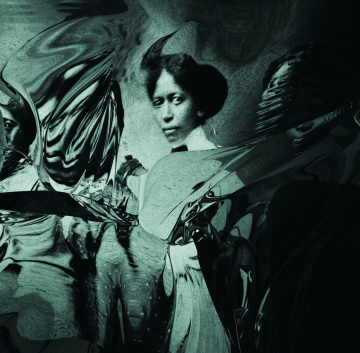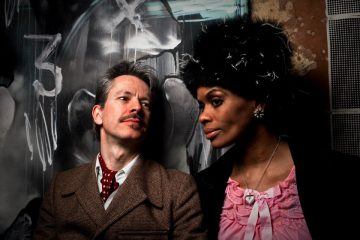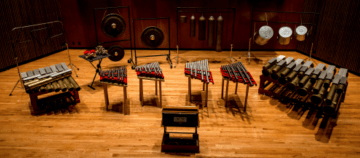by Philip Graham
 I serve as the family cook as well as the family DJ, so no dinner party preparation is complete without a small stack of CDs waiting for guests to arrive. When the doorbell rings and my wife Alma walks to the front door to greet our earliest guests, I idle the burners on the stove and hurry to the living room stereo, where I press Play for the first CD. A song should already be in progress before the exchange of Hellos, because music, like furniture, is a form of home decoration, filling and defining silence the way a couch or chair fills and defines space. The music must be dialed low, just enough for a home to express quiet domestic welcome. I like to think that I’m long past my ancient feckless undergraduate days of booming a song through an open window.
I serve as the family cook as well as the family DJ, so no dinner party preparation is complete without a small stack of CDs waiting for guests to arrive. When the doorbell rings and my wife Alma walks to the front door to greet our earliest guests, I idle the burners on the stove and hurry to the living room stereo, where I press Play for the first CD. A song should already be in progress before the exchange of Hellos, because music, like furniture, is a form of home decoration, filling and defining silence the way a couch or chair fills and defines space. The music must be dialed low, just enough for a home to express quiet domestic welcome. I like to think that I’m long past my ancient feckless undergraduate days of booming a song through an open window.
Yet over dinner, rarely does someone ask, “What is that lovely music?” Such a longed-for question always fills me with joy—someone heard its beauty too!–and I’m happy to reply, “Oh, that’s Brian Eno’s Music for Airports,” or “We’re listening to the Afro-Spanish singer Buika Concha,” or “You like the Kora Jazz Trio, too?” Am I the only one who can be diverted from dinner chitchat by an airy chorus, or a husky vocal phrase, or a tack piano’s piquant modulation?
That magic question does get asked from time to time. I remember in particular one evening, many years ago, when I hit paydirt as guests passed serving plates and bowls back and forth at the dinner table and an austere mix of resonant metallic percussion, choral voices, an organ and a violin wafted from the living room.
“What are we listening to?” my old friend Bruce asked. Bruce! Of all my friends, I knew he had that question in him.
“It’s ‘La Koro Sutro,’ by a contemporary American composer, Lou Harrison.”
“I don’t think I’ve ever heard of him.”
I hadn’t either, until recently, but my description was ready. I have always been an attentive reader of liner notes. “Harrison was influenced by Balinese gamelan music, but what we’re listening to is an American gamelan orchestra.”
“American gamelan?”
“Yeah, Harrison wanted to compose for gamelan instruments, but shipping them from Asia turned out to be too expensive, so he made his own, out of aluminum tubes and oxygen tanks, stuff like that.”
“Now you’re kidding me.”
By this time the dinner conversation had paused.
“No, not at all.” Though sensing my words were failing the pleasure of this music, ever hopeful I plunged on. “It’s a big chorus, too, a hundred people. They’re singing from a Buddhist text called the Heart Sutra. But it’s not translated into English, it’s translated into Esperanto.”
As soon as the word Esperanto left my lips, I understood my boosterism had doomed Lou Harrison’s composition into a kind of joke.
Esperanto. Created in 1887 and once considered a possible universal language and linguistic doorway to world peace, those goals had faded. So much so that, when Bruce repeated “Esperanto,” and a smile spread across his face, no one doubted that his quick sense of humor was about to serve up something snarky.
*
I’ll put Bruce’s comment on hold for the moment, because what this memory primarily brings to my mind is the difficulty of describing music. I write this as no authority, only as an observer of the mysteries of musical attraction.
A good deal of music is often defined in a few words: Oh, that’s folk rock. You listen, and it is. Folk + rock equals etc. Or, that’s a show tune. Done. Yet does music so cozily fit its categories? It’s not that simple. You can’t just stop at: string quartet. You proceed to From what era? The Romantic period. Which composer? Beethoven. What opus number? Op. 132, in A minor. What ensemble’s version? I’m partial to the Quartetto Italiano’s.
Describing music this way resembles building a burger. You start with a patty on a plate, then add a toasted bun, a slice of tomato, a thin circle of onion, a lettuce leaf, a couple tiny disks of sweet pickle, a dollop of ketchup or dab of mustard. Each extra topping adds character, taste.
 But why stop at extra toppings? The best music is more akin to a stew, or a sauce, the slow simmer of tomatoes and tomato paste, olive oil, sweet peppers, garlic cloves (lots, please), onions, a small rind of parmesan (for umami), fresh basil, oregano and mint, a secret spoonful of maple syrup, a heretical shake of nutmeg (have I mentioned that I’m the family cook?), and a few other ingredients I decline to share. Ideally, everything melts into each other to become something never before tasted.
But why stop at extra toppings? The best music is more akin to a stew, or a sauce, the slow simmer of tomatoes and tomato paste, olive oil, sweet peppers, garlic cloves (lots, please), onions, a small rind of parmesan (for umami), fresh basil, oregano and mint, a secret spoonful of maple syrup, a heretical shake of nutmeg (have I mentioned that I’m the family cook?), and a few other ingredients I decline to share. Ideally, everything melts into each other to become something never before tasted.
These culinary thoughts, and my regret at flubbing the La Koro Sutro description test, now loom over me as I prepare to portray the music of Annabel (lee).
*
The moment I saw the cover of the group’s first album, featured on their Bandcamp website page, I knew I had to listen to their music, whatever it was. That cover image featured an African-American woman in nineteenth century dress who stared directly at the viewer, both warily and defiantly, surrounded by a green field of morphing shapes, some of them distorted versions of her face, as if she floated in a fluid suminagashi watercolor.
Annabel (lee)’s music has been variously described as Goth-inspired Jazz or trip-hop cabaret, as influenced by the piano works of Debussy and Satie and the film scores of Bernard Herrmann, bossa nova, blues, the ghostly folk of Nick Drake, and if that’s not enough you’ll also catch the back-up singing of seductive sirens, an electronically-treated string orchestra, and a few other pots and pans from music’s kitchen sink. Annabel (lee) knows how to brew a heady musical stew, and nothing else sounds quite like this.
 Begun as a New York-London trans-Atlantic file sharing relationship that turned into a courtship that turned into a marriage, the duo of Annabel (lee), Sheila Brown Ellis and Richard Ellis, continued their musical collaboration and released their first album, By the Sea . . . and Other Solitary Places, with Sheila writing the lyrics, Richard constructing the arrangements, and both lending a hand at composing the music.
Begun as a New York-London trans-Atlantic file sharing relationship that turned into a courtship that turned into a marriage, the duo of Annabel (lee), Sheila Brown Ellis and Richard Ellis, continued their musical collaboration and released their first album, By the Sea . . . and Other Solitary Places, with Sheila writing the lyrics, Richard constructing the arrangements, and both lending a hand at composing the music.
Sheila Ellis’ impressive Minnie Ripperton-ish vocal range contains within it Nina Simone and Billie Holiday, for starters. Sometimes in a song she will briefly slip into sprechgesang’s uncanny valley of emotionally charged, musical speech. Her endlessly expressive voice is matched by Richard’s endlessly inventive arrangements, in which a flute will turn husky in harmony with a piano ostinado, a harp will insist on avoiding the usual clichéd glissandos and instead pluck every note to a purpose. Even the eerie ondes martenot can shed the damage of its past overuse in science fiction soundtracks and find its best musical soul.
All of this goodness is wrapped up in an obsession with Edgar Allan Poe—the Ellises didn’t simply pick the name of their band out of a hat. I have never been the biggest admirer of Poe’s stories (I’m a Hawthorne fanboy), yet Annabel (lee)’s preoccupation still draws me in. Their lyrics don’t insist on a literal connection with Poe. His name, for example, is never mentioned (well, only once, and just his first name). “Autumn Requiem,” from their second album, The Cleansing, addresses a man who has been orphaned at a young age and then left behind again in adulthood by the death of a loved one; it could be about anyone, though the details track with Poe’s biography. “Scarlett One,” about the distant appraisal of a precocious young girl, could also be about Poe’s child bride, Virginia Clemm.
The closest correspondence they approach is in the song “(1849),” about the year, and season, of Poe’s death, which followed by two years the death of Virginia. But what really captures you is the music, how the piano and stand-up bass collaborate on a slow, slap-release rhythm that walks you right into the moment when Sheila’s voice takes charge.
Annabel (lee)’s deep stew of musical ancestors may be fueled by their fascination with a nineteenth-century American writer, but it isn’t constrained by it. In this rare live performance (they seem to restrict appearances to a handful of clubs in Los Angeles) the band unfolds, in “Paris, Room 14,” some impressive bossa nova chops.
A pair of marvelous EPs appeared two years ago, bread crumbs for hungry music lovers. A third album remains in progress. Or has been delayed. Or who knows why, because the band maintains a minimal presence on the Internet. A search for them requires a certain amount of parting hay for a shiny needle. There’s a singer called Annabel Lee, a bar band named Annabel Lee, a heavy metal unit named Annabel Lee, and so on, and scads of folk songs out there set to the lyrics of Poe’s poem, “Annabel Lee.” The Ellises do maintain a FaceBook page (though somewhat disguised as “Solitary Places”) that features video snippets of new songs but offers no release date, only the promise of “things to come.”
So their fan base–not nearly as extensive as Annabel (lee) deserves–awaits. Impatiently. Hopefully.
Meanwhile, we obsessively listen to what we already have, like the ethereal, “Believe.”
*
Inevitable Coda
You didn’t think I’d forget about Lou Harrison and La Koro Sutro, did you?
First, take a look at these DIY gamelan instruments that Harrison constructed with his life partner, William Colvig. They look far more elegant than you’d think, considering this description from the New York Times: “Aluminum slabs, tin cans, electrical conduit and empty oxygen tanks, cut to various sizes and struck with sawed-off baseball bats, replaced the gongs of the Asian gamelan.”

Now that you can see the instruments, maybe you’d like to listen to the fourth movement of La Koro Sutro, the one where the chorus sings (in Esperanto, the language of peace), “In the voidness there is neither form, nor yet sensation, no perception, no impulses, no awareness; nor the eye, the ear, the nose, the tongue, the body, mind,” because nothing else sounds quite like this.
Punchline Coda
I didn’t forget my old friend’s snarky comment, either. What did Bruce say in response to my bobbled description of La Koro Sutro?
He glanced at the rest of the guests around the dinner table and declared, “Philip belongs to a record club called We Only Made Six of ‘Em.”
We all enjoyed a laugh, and since then Bruce’s comment has joined a select handful of phrases I use to define myself, when so moved. Because it’s true, I do prefer the unbeaten musical path that branches off from the larger unbeaten path. I love, for instance, the haunting harmonies of Albanian men’s vocal music, and if you give me a few minutes I would be happy for the opportunity of converting you to the keening voices and exquisite polyphonic melancholy of the Albanian Men’s Group from Vlorë and their version of “Legend of the Walled-in Woman” (a legend that sounds a little Edgar Allan Poe-ish, doesn’t it?).
Even though nothing else quite sounds like this, you don’t have to listen. Just like, if you sidle up to a friend’s bookshelf, you don’t have to examine the titles on the spines, you don’t have to pull one off the shelf and page through it until you’ve satisfied your curiosity. It’s your choice.
Your choice. Unlike music playing lightly in the background at a dinner party, where the music enters your ears whether you want it to or not, where you may be matching your host’s well-meaning but impolite use of the stereo as a pulpit (I hate to admit it, but it’s true) with your own polite silence, even if (or perhaps because) nothing else sounds quite like this.
